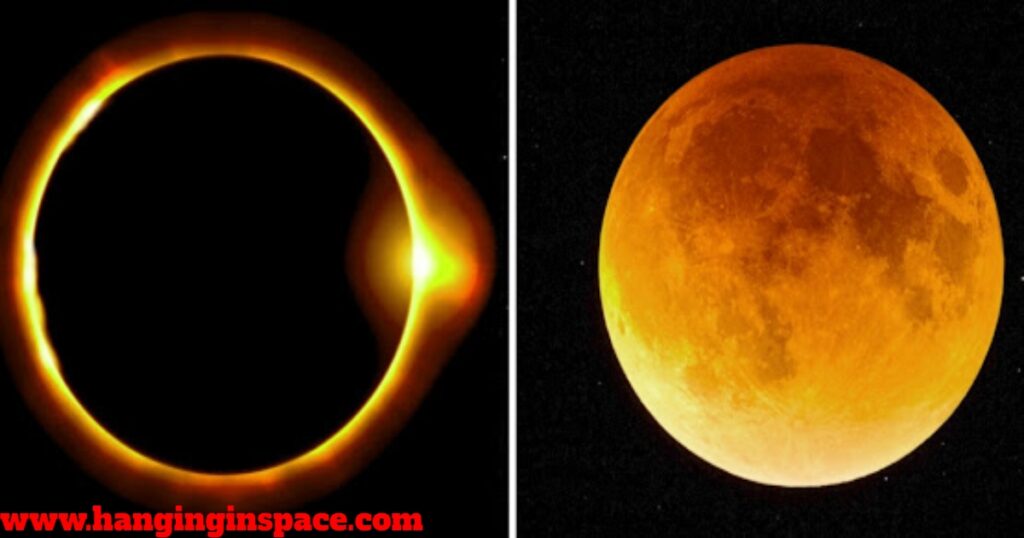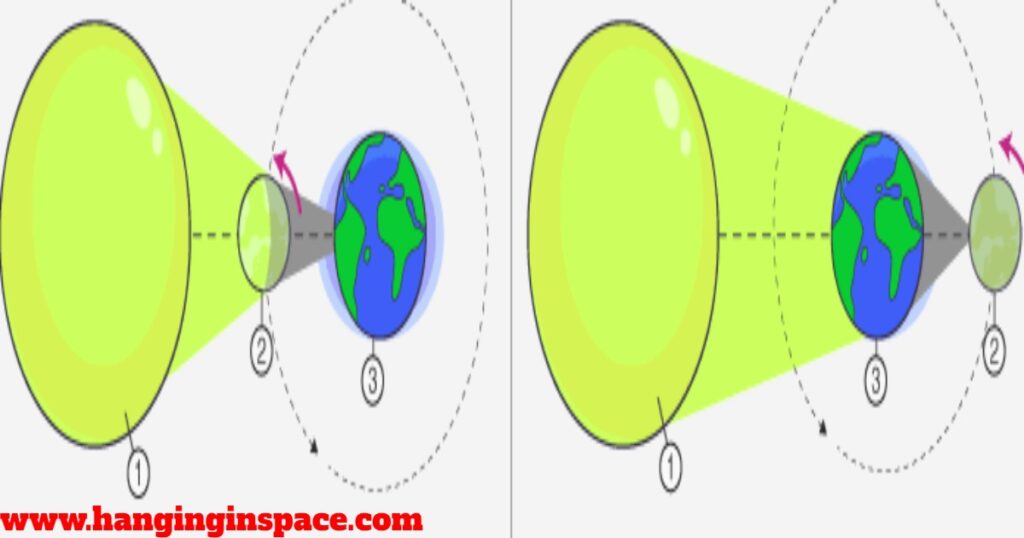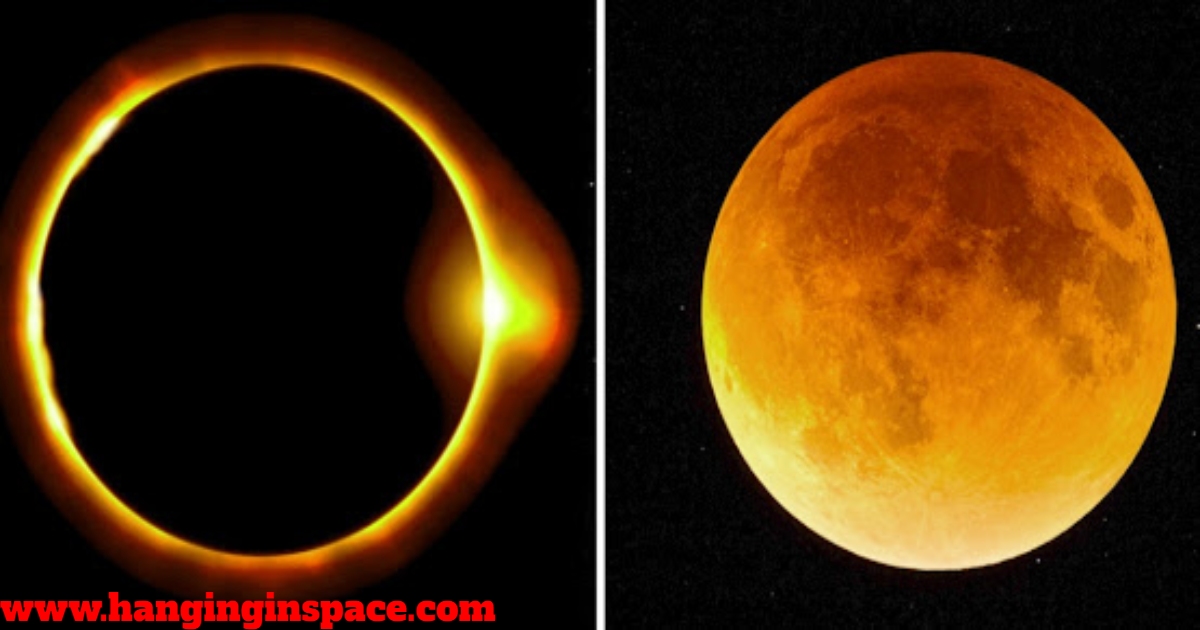The solar eclipse and lunar eclipse are two examples of extraordinary events that fall under the category of cosmic processes and are highly inspiring and admirable to the human senses. For ages, people from all around the world have been drawn to these mesmerizing performances of celestial ballet, which leave viewers feeling creased, shivered, and filled with worship.

What are the Causes of Solar Eclipse and Lunar Eclipse?
When two celestial bodies align such that one casts a shadow over the other, a solar or lunar eclipse takes place, producing amazing displays of light and shadow in the sky.
Why does a Solar Eclipse happen?
A solar eclipse is the result of the Moon passing partially or completely between the Earth and the Sun. It happens when the Moon’s orbit crosses the Sun’s apparent path across the sky. This occurrence takes place during the New Moon phase.
Why does a Lunar Eclipse happen?
A lunar eclipse is a phenomenon in which the Earth passes in front of the Sun and the Moon, casting the Earth’s shadow on the moon’s surface. When the Sun, Earth, and Moon are in alignment during the Full Moon phase, lunar eclipses usually take place.
What are the Types of Solar Eclipse and Lunar Eclipse?
Eclipses of the Sun and Moon seem different and provide various visual displays for those on Earth.
Total Solar Eclipse:
A total solar eclipse occurs when the Moon totally obscures the disk of the Sun, engulfing the surrounding areas in an umbra of darkness.
Partial Solar Eclipse:
In a partial solar eclipse, the Moon only covers a piece of the Sun’s disk, which causes the affected areas to experience a partial reduction in sunlight.
Total Lunar Eclipse:
When the Moon completely passes into the umbral shadow of the Earth, it is said to be a “blood moon” because of its reddish tint. When sunlight refracts through Earth’s atmosphere, it creates this amazing phenomenon that gives the lunar surface a red glow.
Partial Lunar Eclipse:
A partial lunar eclipse causes the lunar disk to partially darken because just a section of the Moon passes into the umbral shadow of the Earth.

What is the importance of solar and lunar eclipses in culture?
Eclipses of the sun and moon have had a profound cultural impact on societies all around the world throughout history. These heavenly occurrences have evoked wonder, terror, and spiritual devotion throughout history, from the tales of the ancients to the discoveries of modern science.
Mythological Interpretations:
Eclipses of the sun and moon were seen by many ancient societies as prophecies or as heavenly conflicts between gods and legendary monsters. These occurrences frequently shaped cultural customs, religious beliefs, and rituals, influencing societies’ collective consciousness.
Scientific Exploration:
Solar and lunar eclipses have been crucial to the advancement of science’s understanding of the cosmos, in addition to their cultural significance. These occurrences have been researched by astronomers and scientists to learn more about the solar system‘s composition, the dynamics of celestial mechanics, and the behavior of light and shadow in space.
Current Observations:
Solar and lunar eclipses continue to amaze viewers in the modern period, attracting both enthusiasts and scientists to witness and record these celestial events. With the development of technology, the international astronomical community has been able to collaborate and engage through live broadcasts, telescopic observations, and scientific studies during eclipses.
Difference between Solar Eclipse and Lunar Eclipse:
Solar Eclipse Vs. Lunar Eclipse:
| Feature | Solar Eclipse | Lunar Eclipse |
|---|---|---|
| Type of Eclipse | Sun is blocked (partially or fully) from view | Earth’s shadow falls on the Moon |
| Cause | Moon comes between the Sun and Earth | Earth comes between the Sun and the Moon |
| Visibility | Only visible from a specific path on Earth where the Sun is blocked | Visible from anywhere on Earth where the Moon is above the horizon (during nighttime) |
| Frequency | Can occur multiple times per year | Can occur up to three times per year |
| Duration | Relatively short (minutes) | Can last for several hours |
| Safety | Looking directly at the Sun during a solar eclipse can damage your eyes | Safe to look at with the naked eye (although some recommend using a neutral density filter for comfort) |
| Moon Phase During Eclipse | New Moon | Full Moon |
Conclusion:
Finally, solar and lunar eclipses serve as enduring reminders of the universe‘s interconnection and people’s ongoing curiosity about space. Let us recognize the rich tapestry of scientific research and cultural heritage that these magnificent events represent as we marvel at the heavenly ballet of light and shadow. Let us accept the wonder and beauty of these moments.
